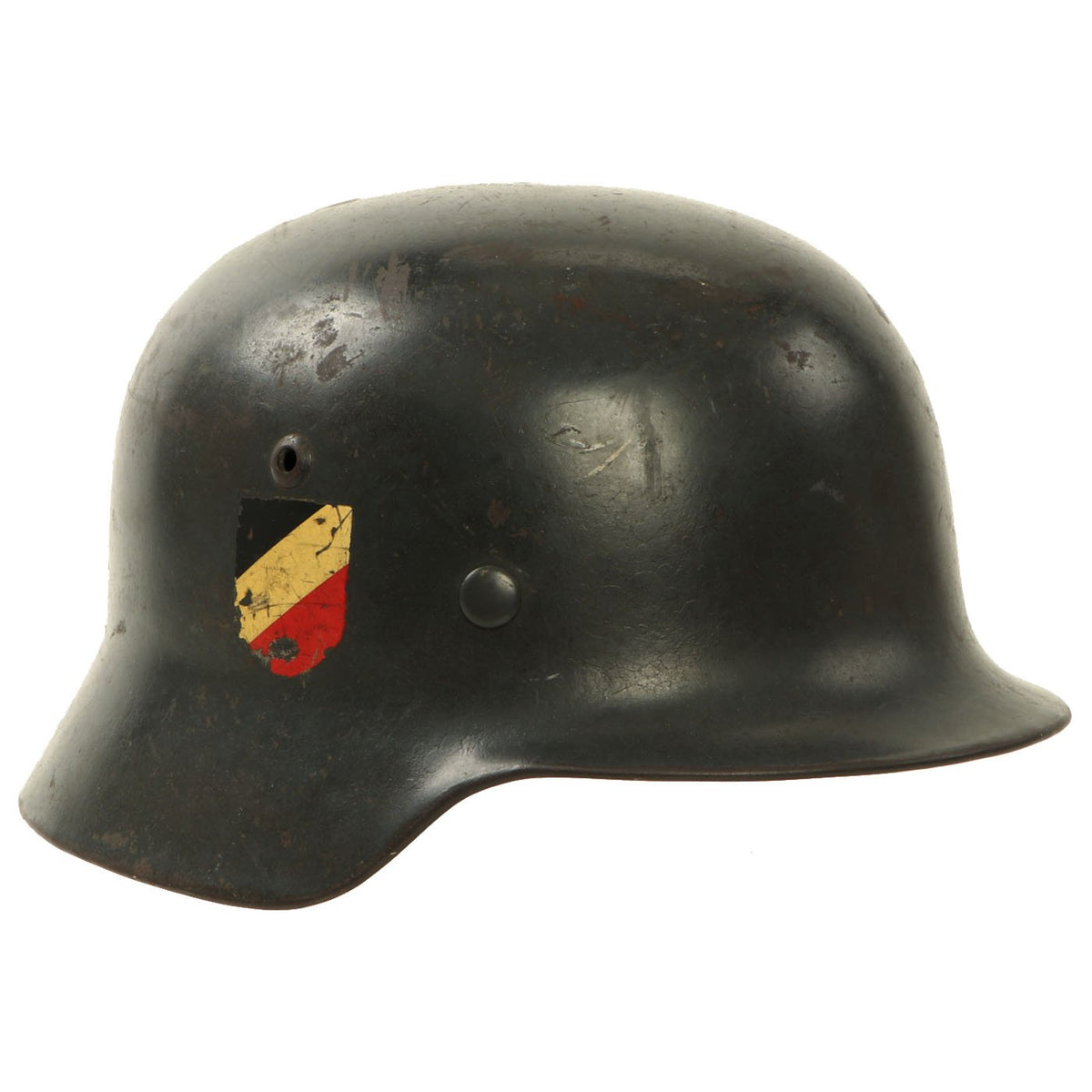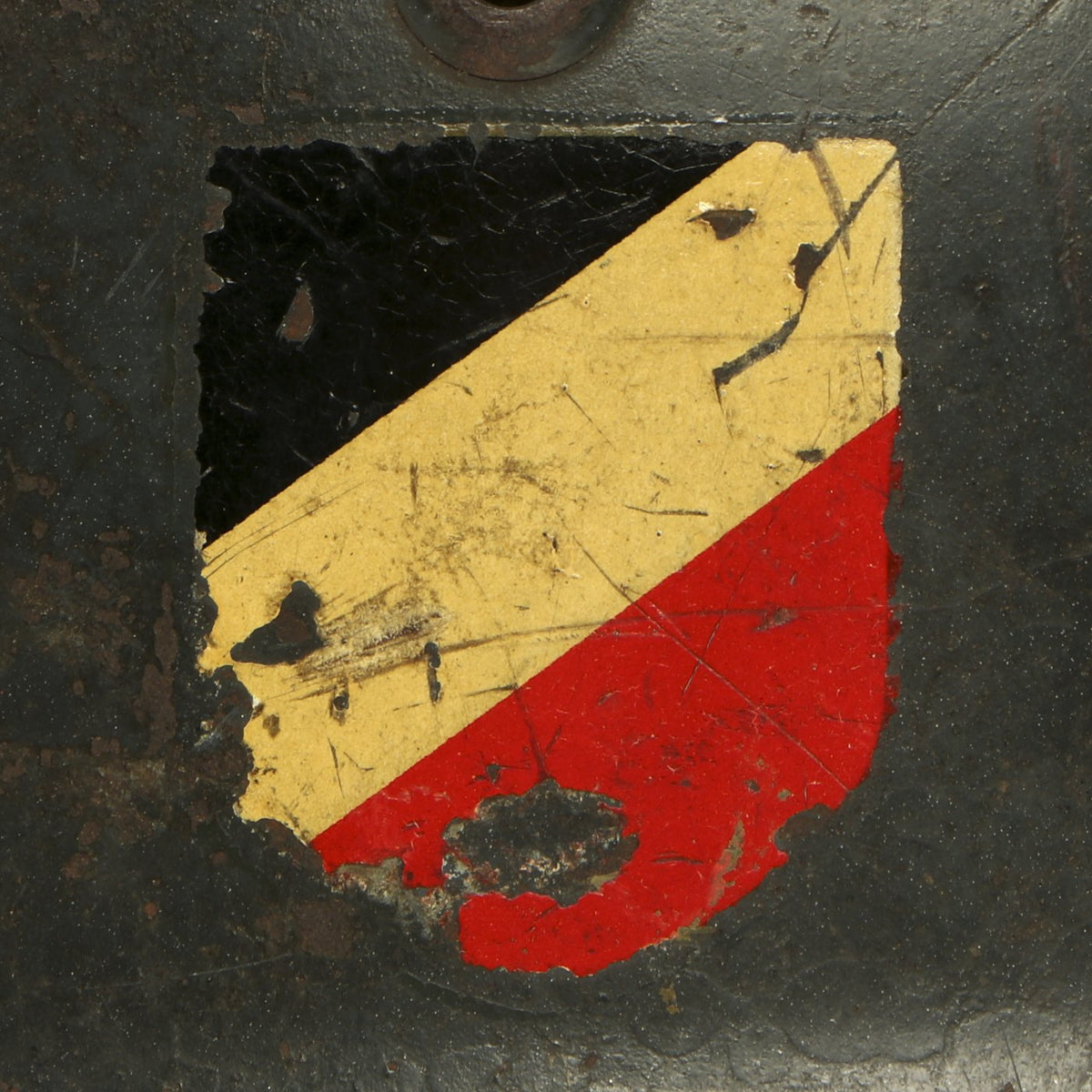Original German WWII 1939 dated Luftwaffe Unit Marked M35 Droop Tail Double Decal Steel Helmet – ET66 Original Items
$ 1.995,00 $ 498,75
Original Item: Only One Available. This is an incredible all original example of a very early Model 1935 German early WWII “double decal” helmet, with lots of history and research potential! It has an early “Droop-Tail” Luftwaffe Eagle decal on the left side, and a “National Colors” decal on the right. The national colors decals were discontinued and removed from most helmets, so finding one with both decals intact is a real treat! Both decals are still retained at over 75%, and both have a lovely aged yellow look from the lacquer coating used on German decals. The paint is the correct smooth blue-gray Luftwaffe fliegerblau used on early helmets, which would later become textured. Just lots to take in, and we aren’t even at the best parts!
The interior of the helmet still has the original “Dome Stamp” inspection mark, which is almost completely legible, a real rarity! It reads:
Abgenommen
I
1939
Beschaffungsamt
für Heer und Marine
This translates basically to “Accepted, 1939, Procurement Office for Army and Navy.” This is absolutely correct for this helmet. It also has two unit markings stamped in boxes, which both read Fl. H. Kdtr. at the top, while one has Gablingen at the bottom, while the other has L’feld. “Fl. H. Kdtr.” is the abbreviation for Fliegerhorstkommandantur, or “Airfield station command”. This helmet looks to have seen service at the Airfields in Gablingen and Lechfeld, which are both located near Augsburg, Bavaria.
The reverse, interior, neck guard apron is serial number stamped 4186, and the interior, left side, apron has the stamped manufacturer’s code and size, ET66 indicating that it was manufactured by Eisenhuttenwerk AG of Thale, located in the Harz district in Saxony, Germany. Size 66 is a nice larger size that can accommodate liners from 58cm to 59cm or US 7 1/4 to 7 5/8. Size 66 shells are harder to find and are therefore more valuable to a collector.
All three of the original liner split pins are present, with most of the original paint intact. The interior of the helmet still has the original M31 leather liner with all eight of its fingers intact and an intact top strap. The leather is still supple, but does show moderate wear, with some small splits on the edge. The early war issue aluminum liner band is marked on the left outer side with 66 n.A. / 58, indicating that the liner is a size 58, intended for a 66 shell. It is also stamped with size 58 in a circle on the leather itself. The right side displays the full manufacture information, as well as a date:
SCHUBERTH-WERKE K.-G.
D. R. P.
1939
BRAUNSCHWEIG
The band is the correct reinforced pattern, with an extra layer of aluminum around the sides to support the chin strap. Soon after this, manufacturers moved to the galvanized steel band. The original chin strap is unfortunately completely missing.
Overall a very nice 100% genuine early double decal Luftwaffe helmet with loads of history and some research potential! We do not get helmets like these very often at all. Ready to display!
The first “modern” steel helmets were introduced by the French army in early 1915 and were shortly followed by the British army later that year. With plans on the drawing board, experimental helmets in the field, (“Gaede” helmet), and some captured French and British helmets the German army began tests for their own steel helmet at the Kummersdorf Proving Grounds in November, and in the field in December 1915. An acceptable pattern was developed and approved and production began at Eisen-und Hüttenwerke, AG Thale/Harz, (Iron and Foundry Works), in the spring of 1916.
These first modern M16 helmets evolved into the M18 helmets by the end of WWI. The M16 and M18 helmets remained in usage through-out the Weimar Reichswehr, (National Defence Force, Circa 1919-1933), era and on into the early years of the Third Reich until the development of the smaller, lighter M35 style helmet in June 1935.
The Luftwaffe pattern national eagle was originally introduced for wear by Fliegerschaft, (Pilot Base), personnel of the DLV, Deutscher Luftsportsverband, (German Air Sports Association), the clandestine, civilian, forerunner of the Luftwaffe on August 18TH 1934, and adopted for wear by the Luftwaffe on March 1ST 1935 along with the national tri-color shield for wear on the helmet.
The first pattern national eagle was utilized until a modified second pattern eagle was introduced in late 1936 or early 1937. Regulations of June 12TH 1940 discontinued the use of the national tri-color decal and further regulations of August 28TH 1943 abolished the national eagle decal and dictated that it was also to be removed from all helmets although the directives were not completely adhered to.
Fast Shipping with Professional Packaging
Thanks to our longstanding association with UPS FedEx DHL, and other major international carriers, we are able to provide a range of shipping options. Our warehouse staff is expertly trained and will wrap your products according to our exact and precise specifications. Prior to shipping, your goods will be thoroughly examined and securely secured. We ship to thousands clients each day across multiple countries. This shows how we're dedicated to be the largest retailer on the internet. Warehouses and distribution centres can be located throughout Europe as well as the USA.
Note: Orders with more than one item will be assigned a processing date depending on the item.
Before shipping before shipping, we'll conduct a thorough inspection of the items you have ordered. Today, the majority of orders will be delivered within 48 hours. The delivery time will be between 3-7 days.
Returns
The stock is dynamic and we cannot completely manage it because multiple stakeholders are involved, including our factory and warehouse. So the actual stock may alter at any time. It's possible that you may not receive your order once the order has been made.
Our policy is valid for a period of 30 days. If you don't receive the product within 30 days, we are not able to issue a refund or an exchange.
You can only return an item if it is unused and in the same state as the day you received it. You must have the item in its original packaging.
Related products
Uncategorized
Uncategorized
Uncategorized
Uncategorized
Uncategorized
Uncategorized
Uncategorized
Uncategorized
Uncategorized
Uncategorized
Uncategorized
Uncategorized
Uncategorized
Australian WWII Owen MK1 Machine Carbine SMG Custom Fabricated Replica with Sling Original Items
Uncategorized
Armored Burgonet Helmet & Polearm from Scottish Castle Leith Hall Circa 1700 Original Items
Uncategorized
Uncategorized













































































